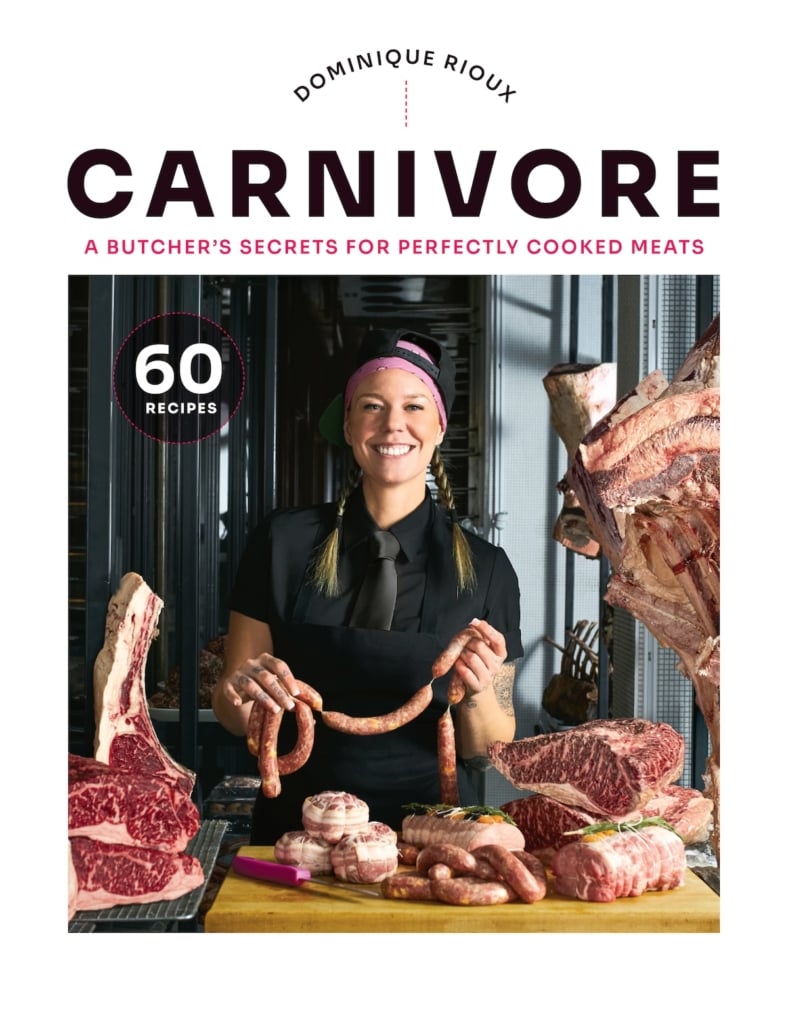YOU ARE HERE >> AmazingRibs » Ratings & Reviews » Ratings Reviews And Buying Guides » Carnivore: A Butcher’s Secrets for Perfectly Cooked Meats, a cookbook review
Get Your Juices Flowing with Carnivore: A Butcher’s Secrets for Perfectly Cooked Meats
All of our reviews are done independently by our team of testers and are in no way influenced by advertising or other monetary compensation from manufacturers. Click here to learn more about our unbiased product review process.
Published On: 11/21/2025 Last Modified: 12/9/2025

With 60 inventive recipes and extensive butchery info, this book will get any meat lover’s juices flowing
Butcher, chef, and meat-lover Dominique Rioux lives in Montreal, Canada, home to smoked meat meccas like Schwartz’s Deli and steakhouses like Joe Beef. She earned a diploma in retail butchering from Montreal’s culinary arts school in 2013—where she was the only woman in her class and won an award of excellence. Dominique has a dynamic personality that’s splashed all over her engaging first cookbook, Carnivore. If you’re a fan of porky puns, meaty metaphors, and Wagyu wordplay, you’ll love Dominique’s playful writing style.
Cookbook review
Originally published in French, Carnivore has been translated into English with chapters devoted to Beef, Pork, Lamb, Offal, Veal, Poultry, and Farmed Game, each organized by cut of meat, including helpful buying information and innovative recipes for retail cuts. Each chapter opens with anatomical drawings showing where wholesale and retails cuts come from on the animal, followed by an at-a-glance table that specifies retail cuts within the wholesale cuts and the best cooking methods for each cut.
The recipes call for meat cuts based on French-Canadian artisan butchery, and the terms don’t always match up with US or Canadian English butcher terms. To slice through any confusion, a handy 14-page “Meat Translator” at the back of the book features clear English, Alternate English, Quebec French, and French terms for multiple meat cuts. For instance, gîte de bœuf = beef shank. The translation of these cuts is a standout feature of Carnivore, allowing meat lovers in various countries to understand terms used in other countries and to cook choice cuts that may be less well-known in their home country.
The back of the book also features osteology drawings, showing the bone structure of every animal covered in Carnivore, along with bone names and a helpful guide to meat cuts that are related to bones, such as “blade roast.” If you want to think like a butcher, know the whole animal, and be more conversant at the meat counter—in a couple different languages—this book helps you get there.
Up front, Dominique gamely explains all the meat cookery basics like toughness and tenderness, meat grades, food safety, and cooking methods. A section on tempering meat explains her logic behind using the method: “meat that is at room temperature will sear much more quickly without cooling down the heat source used for cooking. This will give the surface a nice crisp, even crunchy texture.” She goes on to explain the Maillard reaction, meat aging, and how she salts meat before cooking but only adds spice rubs after searing meat to avoid the bitterness of burnt spices. Dominique prefers to rest meat after cooking “to give it time to adjust and find its balance between two states: cooking and non-cooking.” She also explains meat doneness temperatures and carryover cooking.
Beautiful food photography brightens almost every page, including finished plates of food, huge sides of meat, and retail cuts with diagrams and cut marks showing how to butcher various primals and subprimals. It’s very useful info for saving money on meat: buy bigger cuts and butcher them yourself instead of paying your butcher to do it. Various graphs and illustrations also provide details on the best cooking methods for various cuts along with novel recipes.
60 Recipes
Carnivore features 60 original recipes that utilize the meat cuts detailed in the book. Many are destined for the grill or smoker, and some for the stove. Try easier weeknight dishes like Chicken Legs with Roasted Carrots, Pistachios, and Feta or splurge on fancier fare such as Filet Mignon with Bone Marrow, Escargots, and Arugula Pesto. For the adventurous, there are daring dishes like Calf Brain Popcorn with Pesto Parmesan Mayo and Deer Frenched Center Cut Chop with Sea Buckthorn and Bacon Marmalade.
Some of Dominique’s methods and techniques don’t line up perfectly with the Meathead Method used throughout this website, but they still yield excellent results. For instance, when using the Texas Crutch on racks of ribs, we recommend wrapping them for a maximum time of 1 hour. Dominique wraps her ribs for 2 hours, using a 2-2-1 method: smoke for 2 hours, wrap for 2 hours, and then baste with sauce in the smoker for 1 hour. To taste the results, check out her recipe for Spareribs + Baby-Cue Sauce + Apricots, which she generously agreed to share with us.
For juicy smoked brisket, Dominique uses an injection of beef stock, beef tallow, soy sauce, Worcestershire sauce and seasoned vegetable cocktail (V8). She chills the injected brisket overnight, then smokes it between 250 and 275°F to an internal temp of 175°F. Then she sprays it with cola, wraps it in butcher paper with a little more cola and continues smoking it at 275°F to an internal temp of 190°F. Then she lets it rest, wrapped, for about 45 minutes, before unwrapping and slicing. Curious? Try it yourself with her recipe here for Brisket + Smoke + Cholesterol.
Other inventive recipes include beef stew baked in a pumpkin; grilled lamb T-bones with tabouli and garlic yogurt; and a wheel of brie wrapped in thin-sliced beef ribeye that’s seared on the grill in a hot cast-iron skillet with some vegetables, and then served with grilled bread. I might be trying that one over the holidays. And if I really need to impress a devout carnivore, I may be serving Dominique’s whole Thor’s hammer (beef shank) injected, smoked, and served with a wick in the marrow and lit like a candle.
Most recipes have no headnotes, but Dominique includes cheeky Notes, Prep Times, Cooking Times, and Yields, saying things like “Serves 6 reasonable people or 4 unreasonable ones” and “Serves 7 armchair athletes or 4 to 5 football players.” All in all, Carnivore is a lively read with sharp observations and very little extra fat from a celebrated Canadian butcher. The book includes enough creative flavor combinations to motivate any meat lover into the kitchen or out to the grill or smoker to sear up something delicious. And if your carnal cravings accompany a penchant for puns, you and Dominique will get along swimmingly. A solid Gold medal.
Click the buttons below to search our complete database of reviews:
Product Information:
-
Item Price :34.95
*Price Subject To Change -
Where to buy: ** buying from one of these suppliers will help support this website.
Related articles
- Feast on Celebrity Butcher Dominique Rioux’s Smoked Brisket
- Get A Taste of Celebrity Butcher Dominique Rioux’s Smoked Ribs with Apricot BBQ Sauce
Related reviews
- The Meathead Method: The Latest Book From AmazingRibs.com’s Founder
- Meathead: The Science of Great Barbecue and Grilling
- Review of Steak House: The People, The Places, The Recipes by Eric Wareheim with Gabe Ulla
-
Dave Joachim, AmazingRibs.com Editorial Director - Editorial Director of AmazingRibs.com, David Joachim has authored, edited, or collaborated on more than 50 cookbooks, four of them on barbecue and grilling, and his Food Science column appeared in "Fine Cooking" magazine from 2011 to 2019. He’s a perfect match for a website dedicated to the “Science of Barbecue and Grilling.”
Up Your BBQ IQ By Joining The Pitmaster Club

Sign up for a free trial of the AmazingRibs.com Pitmaster Club and experience everything that the world’s largest membership-based BBQ and grilling community has to offer!

High quality websites are expensive to run. If you help us, we’ll pay you back bigtime with an ad-free experience and a lot of freebies!
Millions come to AmazingRibs.com every month for high quality tested recipes, tips on technique, science, mythbusting, product reviews, and inspiration. But it is expensive to run a website with more than 2,000 pages and we don’t have a big corporate partner to subsidize us.
Our most important source of sustenance is people who join our Pitmaster Club. But please don’t think of it as a donation. Members get MANY great benefits. We block all third-party ads, we give members free ebooks, magazines, interviews, webinars, more recipes, a monthly sweepstakes with prizes worth up to $2,000, discounts on products, and best of all a community of like-minded cooks free of flame wars. Click below to see all the benefits, take a free 30 day trial, and help keep this site alive.
Post comments and questions below
1) Please try the search box at the top of every page before you ask for help.
2) Try to post your question to the appropriate page.
3) Tell us everything we need to know to help such as the type of cooker and thermometer. Dial thermometers are often off by as much as 50°F so if you are not using a good digital thermometer we probably can’t help you with time and temp questions. Please read this article about thermometers.
4) If you are a member of the Pitmaster Club, your comments login is probably different.
5) Posts with links in them may not appear immediately.
Moderators